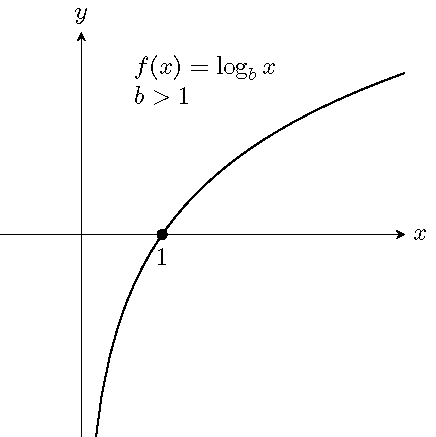Topic 17 Logarithmic Functions
17.1 Estimate the Number of Digits
Can you estimate the number of digits in the integer part of the number 2^{15}\times \sqrt{2020}\div 2021?
17.2 Definition and Graphs of Logarithmic Function
For x>0, b>0 and b\neq 1, there is a unique number y satisfying the equation b^y=x. We denote the unique number y by \log_bx, read as logarithm to the base b of x. In other words, the defining relation between exponentiation and logarithm is y=\log_bx \quad\text{if and only if} \quad b^y=x. The function f(x)=\log_bx is called the logarithmic function f of x with the base b.
Graphs of logarithmic functions:


17.3 Common Logarithms and Natural Logarithms
A logarithmic function f(x) with base 10 is called the common logarithmic function and denoted by f(x)=\log x.
A logarithmic function f(x) with base the natural number e is called the natural logarithmic function and denoted by f(x)=\ln x.
17.4 Basic Properties of Logarithms
When b>0 and b\neq 1, and x>0, we have
- b^{\log_bx}=x.
- \log_b(b^x)=x.
- \log_bb=1 and \log_b1=0.
Example 17.1 Convert between exponential and logarithmic forms.
- \log x=\frac{1}{2}
- 3^{2x-1}=5
Solution.
When converting between exponential and logarithmic forms, we move the base from one side to the other side, then add or drop the log sign.
- Move the base 10 to the right side and drop the log from the left: x=10^{\frac{1}{2}}
- Move the 3 to the right and add log the the right: 2x-1=\log_35
Example 17.2 Evaluate the logarithms.
- \log_42
- 10^{\log(\frac{1}{2})}
- \log_5(e^0)
Solution.
The key is to rewrite the log and the power so that they have the same base.
- \log_42= \log_44^{\frac{1}{2}}=\frac{1}{2}.
- 10^{\log\frac{1}{2}}=10^{\log_{10}\frac{1}{2}}=\frac12
- \log_5(e^0)=\log_51=0
Example 17.3 Find the domain of the function f(x)=\ln(2-3x).
Solution.
The function has a real output if 2-3x>0. Solving the inequality, we get x<\frac{2}{3}. So the domain of the function is (-\infty, \frac{2}{3}).
17.5 Properties of Logarithms
For M>0, N>0, b>0 and b\neq 1, we have
- (The product rule) \log_b(MN)=\log_bM+\log_bN
- (The quotient rule) \log_b(\frac MN)=\log_bM-\log_bN.
- (The power rule) \log_b(M^p)=p\log_bM, where p is any real number.
- (The change-of-base property) \log_bM=\dfrac{\log_aM}{\log_ab}, where a>0 and a\neq 1. In particular, \log_bM=\dfrac{\log M}{\log b} \quad\text{and}\quad \log_bM=\dfrac{\ln M}{\ln b}.
Example 17.4 Expand and simplify the logarithm \log_2\left(\frac{8\sqrt{y}}{x^3}\right).
Solution.
\begin{aligned} \log_2\left(\frac{8\sqrt{y}}{x^3}\right)&=\log_2(8\sqrt{y})-\log_2(x^3)\\ &=\log_28+\log_2(y^{\frac{1}{2}})-3\log_2x\\ &=3+\frac{1}{2}\log_2y-3\log_2x. \end{aligned}
Example 17.5 Write the expression 2\ln(x-1)-\ln(x^2+1) as a single logarithm.
Solution.
2\ln(x-1)-\ln(x^2+1)=\ln((x-1)^2)-\ln(x^2+1)=\ln\left(\frac{(x-1)^2}{x^2+1}\right).
Example 17.6 Evaluate the logarithm \log_34 and round it to the nearest tenth.
Solution.
On most scientific calculator, there are only the common logarithmic function LOG and the natural logarithmic function LN. To evaluate a logarithm based on a general number, we use the change-of-base property. In this case, the value of \log_34 is \log_34=\frac{\log4}{\log3}\approx 1.3.
Example 17.7 Simplify the logarithmic expression \log_2(x^{\log 3})\log_32.
Solution.
\log_2(x^{\ln 3})\log_32 =(\ln 3\log_2x)\log_32=\ln3\left(\frac{\ln x}{\ln 2}\right)\left(\frac{\ln 2}{\ln 3}\right)=\ln x.
17.6 Practice
Problem 17.1 Write each equation into equivalent exponential form.
- \log_37=y
- 3=\log_b64
- \log x=y
- \ln(x-1)=c
Problem 17.2 Write each equation into equivalent logarithmic form.
- 7^x=10
- b^5=2
- e^{2y-1}=x
- 10^x=c^2+1
Problem 17.3 Evaluate.
- \log_216
- \log_93
- \log 10
- \ln 1
Problem 17.4 Evaluate.
- e^{\ln 2}
- \log 10^{\frac13}
- \ln(\sqrt{e})
- \log_2(\frac12)
Problem 17.5 Find the domain of the function f(x)=\log(x-5). Write in interval notation.
Problem 17.6 Sketch the graph of each function and find its range.
- f(x)=\log_2x
- f(x)=\log_{\frac12} x
Problem 17.7 Expand the logarithm and simplify.
- \log(100x)
- \ln\left(\frac{10}{e^2}\right)
- \log_b(\sqrt[3]{x})
- \log_7(\frac{x^2\sqrt{y}}{z})
Problem 17.8 Expand the logarithm and simplify.
- \log_b\sqrt{\frac{x^2y}{5}}
- \ln(\sqrt[3]{(x^2+1)y^{-2}})
- \log(x\sqrt{10x}-\sqrt{10x})
Problem 17.9 Write as a single logarithm.
- \frac13\log x +\log y
- \frac12\ln(x^2+1)-2\ln x
- \frac13\log_2 x - 3\log_2(x+1)+1
Problem 17.10 Write as a single logarithm.
- 2\log(2x+1)-\frac12\log x
- 3\ln x - 5\ln y + \frac{1}{2}\ln z
- 3\log_3 x-2\log_3(1-x)+\frac13\log_3 (x^2+1).
Problem 17.11 Evaluate the logarithm and round it to the nearest hundredth.
- \log_2 10
- \log_3 5
- \dfrac{1}{\log_52}
- \log_45-\log_29
Problem 17.12 Simplify the logarithmic expression \frac{\log_3(x^2)\log_y\sqrt{3}}{\log x}.